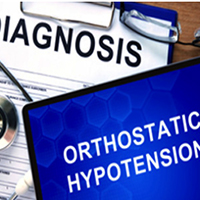Orthostatic hypotension in older adults: the role of medications

Submitted: February 21, 2020
Accepted: April 22, 2020
Published: November 20, 2020
Accepted: April 22, 2020
Abstract Views: 1755
PDF: 902
Publisher's note
All claims expressed in this article are solely those of the authors and do not necessarily represent those of their affiliated organizations, or those of the publisher, the editors and the reviewers. Any product that may be evaluated in this article or claim that may be made by its manufacturer is not guaranteed or endorsed by the publisher.
All claims expressed in this article are solely those of the authors and do not necessarily represent those of their affiliated organizations, or those of the publisher, the editors and the reviewers. Any product that may be evaluated in this article or claim that may be made by its manufacturer is not guaranteed or endorsed by the publisher.
Similar Articles
- Barbara Bordoni, Stefano Urbinati, Alicia Tosoni, Graziana Labanti, Alba Brandes, Cardiologic evaluation of patients undergoing chemoterapy , Monaldi Archives for Chest Disease: Vol. 82 No. 2 (2014): Cardiac series
- Sunil K. Chhabra, Devi Jyoti Dash, Concurrent sensitization to Aspergillus Fumigatus in tropical pulmonary eosinophilia , Monaldi Archives for Chest Disease: Vol. 81 No. 1-2 (2015): Pulmonary series
- K. Malagari, S. Papiris, Fibrosing mediastinitis causing rapidly progressive dyspnea, pulmonary edema and death in a 16 yr old male , Monaldi Archives for Chest Disease: Vol. 61 No. 2 (2004): Pulmonary series
- G. Domenighetti, A. Moccia, R. Gayer, Observational case-control study of non-invasive ventilation in patients with ARDS , Monaldi Archives for Chest Disease: Vol. 69 No. 1 (2008): Pulmonary series
- Francesco Fattirolli, Elisabetta Angelino, The bare minimum of information at discharge after acute coronary syndrome. Part 2: the quality improvement project , Monaldi Archives for Chest Disease: Vol. 78 No. 3 (2012): Cardiac series
- Michele Correale, Fiorella De Rosa, Riccardo Ieva, Matteo Di Biase, Natale Daniele Brunetti, Long-term treatment with high-dose of sildenafil in a thalassemic patient with pulmonary hypertension , Monaldi Archives for Chest Disease: Vol. 78 No. 2 (2012): Cardiac series
- Giuseppe Caramia, Romualdo Belardinelli, Hyperhomocysteinemia in developing age and nutritional aspects of folates: an early cardiovascular risk factor , Monaldi Archives for Chest Disease: Vol. 66 No. 4 (2006): Cardiac series
- R. Luzzati, M. Confalonieri, A. Cazzadori, P. Della Loggia, R. Cifaldi, C. Fabris, M. Biolo, M. Borelli, C. Longo, E. Concia, Prolonged hospitalisation for immigrants and high risk patients with positive smear pulmonary tuberculosis , Monaldi Archives for Chest Disease: Vol. 75 No. 2 (2011): Pulmonary series
- G. Garuti, G. Bandiera, M.S. Cattaruzza, L. Gelati, J.F. Osborn, S. Toscani, M. Confalonieri, M. Lusuardi, Out-of-hospital helmet CPAP in acute respiratory failure reduces mortality: a study led by nurses , Monaldi Archives for Chest Disease: Vol. 73 No. 4 (2010): Pulmonary series
- Erick Chan, Francesco Giallauria, Carlo Vigorito, Neil A. Smart, Exercise training in heart failure patients with preserved ejection fraction: a systematic review and meta-analysis , Monaldi Archives for Chest Disease: Vol. 86 No. 1-2 (2016): Cardiac series
<< < 6 7 8 9 10 11 12 13 14 15 > >>
You may also start an advanced similarity search for this article.

 https://doi.org/10.4081/monaldi.2020.1254
https://doi.org/10.4081/monaldi.2020.1254




